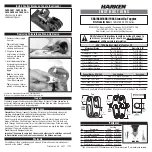
18
EMX has built-in cue speakers, if external cue speakers are not needed the
CUE OUT could be used to connect the Telco Mix to a call recorder output.
If the console does not have an associated talk studio, the STU OUT jack
can also be connected to a different source and used to feed a skimmer,
an internet streamer, or other device. Likewise, if the HDPN OUT is not
needed to connect to an outboard headphone amp it can be connected to
another source to create yet another line output on the Mix Engine.
Note: The built-in ¼” headphone jack, on the right side of
Surface, is also controlled by the HDPN fader but it is not affected
when the HDPN OUT jack on the Mix Engine gets changed to an
alternate source.
Additional Operational Features
This section covers some of the special operational features found on the
EMX Surface including using the Off Line bus and assigning sources for the
Monitor Control panel monitor and meter select buttons, as well as how to
adjust input and output levels/signal balances and set mic and monitor
muting.
Callers & Remotes
The EMX console uses the WheatNet-IP bus-minus convention to create
a unique To Network return audio signal when a caller or remote is the
channel source. Callers and remotes are collectively called Telco devices
(phone hybrids and codecs are the most common Telco devices).
A Telco device has a From Network audio signal, which is set as the
channel source, and a To Network audio signal, which is returned to the
Telco device so the caller/remote hears the board operator or the on-air
signal—but always minus their own From Network audio. This To Network
audio signal is typically derived from the Telco channel’s bus-minus signal
which can be manually connected to the hybrid or codec using the
Crosspoint tab in PR&E Navigator or automatically connected using an
Associated Connection, each method is covered in detail in Chapter 3.
The Off Line (OL) bus is typically used to create the To Network signal
for phone callers and for remotes when they are not on-air, so that the
board operator and/or producer can carry on a hands-free conversation
with them. When the caller or remote goes live, the PGM 1 bus is typically
used to create the To Network signal so that they hear everything else
going to air (but always minus their own audio).
When a channel’s source is a Telco device, the Auto FB and TB
(Talkback) buttons are activated. The Auto Fold Back feature, active
when the Auto FB button is lit, automatically switches the To Network
signal between the OL bus, while the channel is off, and the on-air PGM
bus (typically PGM 1), when the channel is turned on. This feature is used
when the caller or remote will go live to air so that the board operator
does not have to change any board settings to have the To Network return
audio automatically switch from the OL bus to the PGM 1 bus. Of course, if
the board operator needs to talk to the caller or remote while they are
live, they can press the TB button to override the PGM bus-minus audio to
talk to the caller or remote using the board operator mic.
When a caller or remote is assigned to a dedicated fader channel, setting
up their Telco device is simple: the From Network audio signal is “dialed
up” on that fader channel and that fader channel’s bus-minus signal is
connected (using PR&E Navigator) to the output that connects to the
phone hybrid or codec.
When callers (or more likely remotes) are made visible on multiple fader
channels, things get more complicated since now their mix-minus signal,
which is derived from the bus-minus signal on the channel the caller or
remote is taken on, also has to be changed. Fortunately, the PR&E
Navigator Associated Connections feature allows you to set up a “trigger
condition” for the system to monitor (like a codec being dialed up on fader
channel 15). One or more actions are then set to occur when that trigger
condition is detected by the system. In this example, when the
codec/remote is taken on fader channel 15, the system responds by
connecting the bus-minus for fader 15 back to that codec/remote.
Typically one sets up an Associated Connection for each fader that a
codec is set visible on so that no matter which channel the codec is taken
on, it will always be connected to the correct bus-minus signal. Setting up
Associated Connections is covered in Chapter 3 on page 43.
Using the Off Line Bus
Typically, the board operator mic and the caller/remote channel is
assigned to the OL bus. The caller/remote channel’s Off Line button blinks
indicating the OL bus is the bus-minus source for that caller/remote. Their
channel is off and assigned to cue so the board operator can hear the
caller/remote and carry on a hands-free conversation using their mic.
If a Host or call screener need to talk to the caller/remote, their mic
channels would be assigned to OL as well. They would then talk to the
caller using their mics and hear the caller through the cue speakers.
Telco Device Connections
Each caller/remote device’s From Network signal typically connects to a
Razor analog or digital input with two devices sharing a common RJ45 jack
input, which is set for two mono signals rather than one stereo signal.
A Razor mono analog or digital output is then connected to the To
Network input on the caller/remote device. The caller/remote output is
connected, in PR&E Navigator’s Crosspoint tab, to the bus-minus signal for
the channel that the caller/remote is on. See the note on the next page
regarding mono vs. stereo signals on Razor I/O Interfaces.
















































